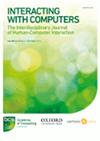Prescriptive and Semantic Analysis of an Automatic Sign Language Translation: Cases on VLibras Avatar Translation Using Video Interviews and Textual Interactions With a Chatbot
IF 1.3
4区 计算机科学
Q3 COMPUTER SCIENCE, CYBERNETICS
引用次数: 0
Abstract
Algorithms designed to translate textual content into sign language (SL) expressed through avatars have been used to reduce accessibility barriers. Our research aimed to identify whether the VLibras tool, widely adopted on Brazilian government websites, is an effective accessibility solution for automatic translation into SL. It is an exploratory and applied qualitative research project involving a bibliographic review and support from expert interpreters. We conducted two experimental studies using sequential chronological cuts and applying prescriptive and semantic analyses. We present evidence that there is no actual translation into SL in the automatic translation process performed by the VLibras translation algorithm (TA) but only a transposition of part of the SL lexicon to the Portuguese morphosyntactic structure. The automatic translation of long texts and texts with complex syntactic structures results in excessive pauses and dactylology for words that have a sign registered in the basic SL dictionary. Using human–computer interaction concepts to evaluate automatic translation into sign language by the VLibras TA expands the existing theoretical discussion. It also contributes to minimizing communication problems caused by the discrepancy between the original message and the machine translation, a practical applicability of this study.手语自动翻译的规定性和语义分析——以VLibras虚拟形象翻译为例,基于视频访谈和聊天机器人的文本交互
旨在将文本内容翻译成通过化身表达的手语(SL)的算法已被用于减少可访问性障碍。我们的研究旨在确定在巴西政府网站上广泛使用的VLibras工具是否是一个有效的自动翻译成SL的可访问性解决方案。这是一个探索性和应用性质的研究项目,涉及书目审查和专家口译员的支持。我们进行了两项实验研究,使用顺序时间切割和应用规范和语义分析。我们提供的证据表明,在VLibras翻译算法(TA)执行的自动翻译过程中,没有实际的翻译到SL,而只是将部分SL词汇转换为葡萄牙语的形态句法结构。长文本和具有复杂句法结构的文本的自动翻译会导致在基本语言词典中注册了符号的单词出现过多的停顿和dactyology。利用人机交互的概念来评价VLibras TA的手语自动翻译,扩展了现有的理论讨论。它还有助于最大限度地减少因原信息与机器翻译不一致而造成的沟通问题,这是本研究的实际适用性。
本文章由计算机程序翻译,如有差异,请以英文原文为准。
求助全文
约1分钟内获得全文
求助全文
来源期刊

Interacting with Computers
工程技术-计算机:控制论
CiteScore
2.70
自引率
0.00%
发文量
12
审稿时长
>12 weeks
期刊介绍:
Interacting with Computers: The Interdisciplinary Journal of Human-Computer Interaction, is an official publication of BCS, The Chartered Institute for IT and the Interaction Specialist Group .
Interacting with Computers (IwC) was launched in 1987 by interaction to provide access to the results of research in the field of Human-Computer Interaction (HCI) - an increasingly crucial discipline within the Computer, Information, and Design Sciences. Now one of the most highly rated journals in the field, IwC has a strong and growing Impact Factor, and a high ranking and excellent indices (h-index, SNIP, SJR).
 求助内容:
求助内容: 应助结果提醒方式:
应助结果提醒方式:


